Page 434 of 525
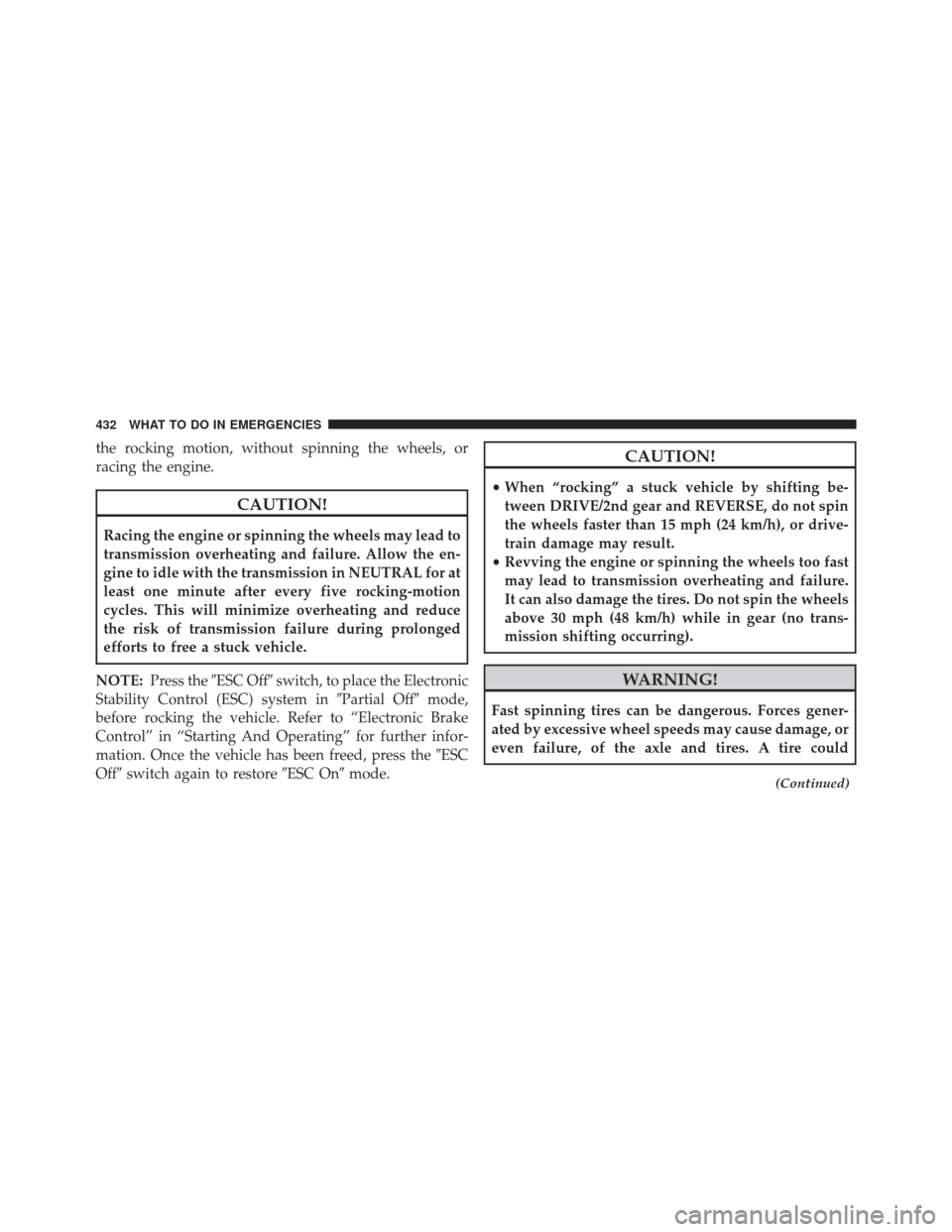
the rocking motion, without spinning the wheels, or
racing the engine.
CAUTION!
Racing the engine or spinning the wheels may lead to
transmission overheating and failure. Allow the en-
gine to idle with the transmission in NEUTRAL for at
least one minute after every five rocking-motion
cycles. This will minimize overheating and reduce
the risk of transmission failure during prolonged
efforts to free a stuck vehicle.
NOTE: Press the �ESC Off� switch, to place the Electronic
Stability Control (ESC) system in �Partial Off�mode,
before rocking the vehicle. Refer to “Electronic Brake
Control” in “Starting And Operating” for further infor-
mation. Once the vehicle has been freed, press the �ESC
Off� switch again to restore �ESC On�mode.
CAUTION!
•When “rocking” a stuck vehicle by shifting be-
tween DRIVE/2nd gear and REVERSE, do not spin
the wheels faster than 15 mph (24 km/h), or drive-
train damage may result.
• Revving the engine or spinning the wheels too fast
may lead to transmission overheating and failure.
It can also damage the tires. Do not spin the wheels
above 30 mph (48 km/h) while in gear (no trans-
mission shifting occurring).
WARNING!
Fast spinning tires can be dangerous. Forces gener-
ated by excessive wheel speeds may cause damage, or
even failure, of the axle and tires. A tire could
(Continued)
432 WHAT TO DO IN EMERGENCIES
Page 457 of 525
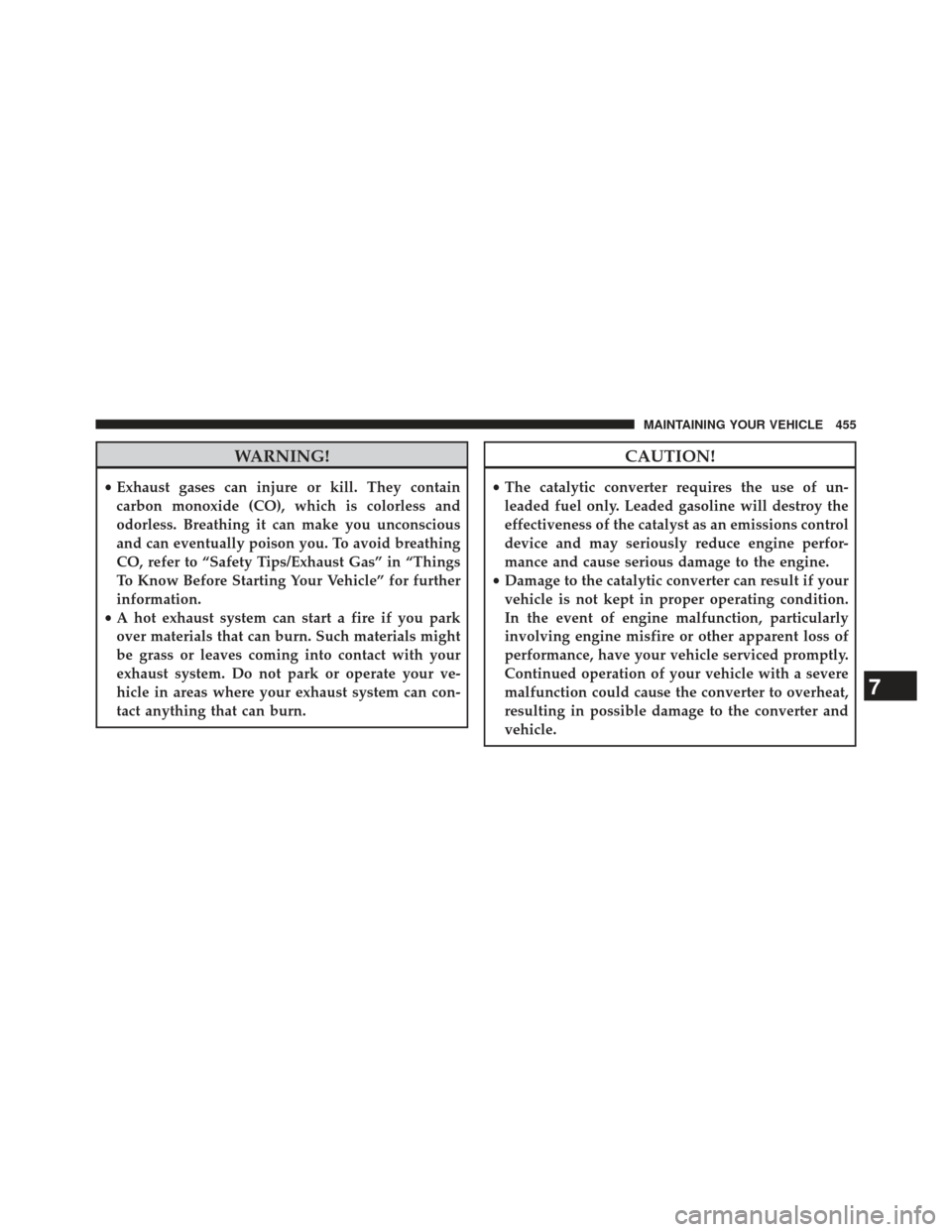
WARNING!
•Exhaust gases can injure or kill. They contain
carbon monoxide (CO), which is colorless and
odorless. Breathing it can make you unconscious
and can eventually poison you. To avoid breathing
CO, refer to “Safety Tips/Exhaust Gas” in “Things
To Know Before Starting Your Vehicle” for further
information.
• A hot exhaust system can start a fire if you park
over materials that can burn. Such materials might
be grass or leaves coming into contact with your
exhaust system. Do not park or operate your ve-
hicle in areas where your exhaust system can con-
tact anything that can burn.
CAUTION!
• The catalytic converter requires the use of un-
leaded fuel only. Leaded gasoline will destroy the
effectiveness of the catalyst as an emissions control
device and may seriously reduce engine perfor-
mance and cause serious damage to the engine.
• Damage to the catalytic converter can result if your
vehicle is not kept in proper operating condition.
In the event of engine malfunction, particularly
involving engine misfire or other apparent loss of
performance, have your vehicle serviced promptly.
Continued operation of your vehicle with a severe
malfunction could cause the converter to overheat,
resulting in possible damage to the converter and
vehicle.
7
MAINTAINING YOUR VEHICLE 455
Page 458 of 525
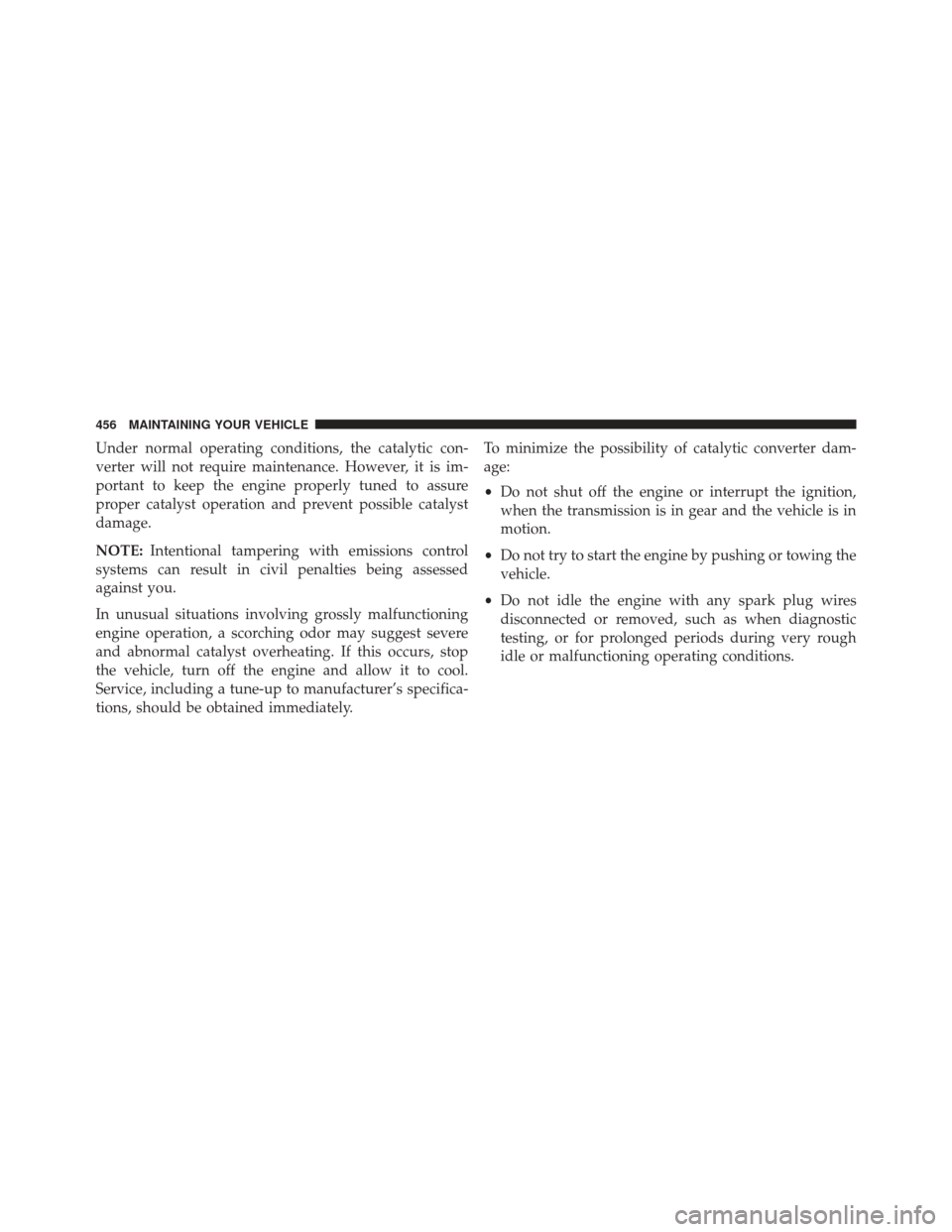
Under normal operating conditions, the catalytic con-
verter will not require maintenance. However, it is im-
portant to keep the engine properly tuned to assure
proper catalyst operation and prevent possible catalyst
damage.
NOTE:Intentional tampering with emissions control
systems can result in civil penalties being assessed
against you.
In unusual situations involving grossly malfunctioning
engine operation, a scorching odor may suggest severe
and abnormal catalyst overheating. If this occurs, stop
the vehicle, turn off the engine and allow it to cool.
Service, including a tune-up to manufacturer’s specifica-
tions, should be obtained immediately. To minimize the possibility of catalytic converter dam-
age:
•
Do not shut off the engine or interrupt the ignition,
when the transmission is in gear and the vehicle is in
motion.
• Do not try to start the engine by pushing or towing the
vehicle.
• Do not idle the engine with any spark plug wires
disconnected or removed, such as when diagnostic
testing, or for prolonged periods during very rough
idle or malfunctioning operating conditions.
456 MAINTAINING YOUR VEHICLE
Page 462 of 525
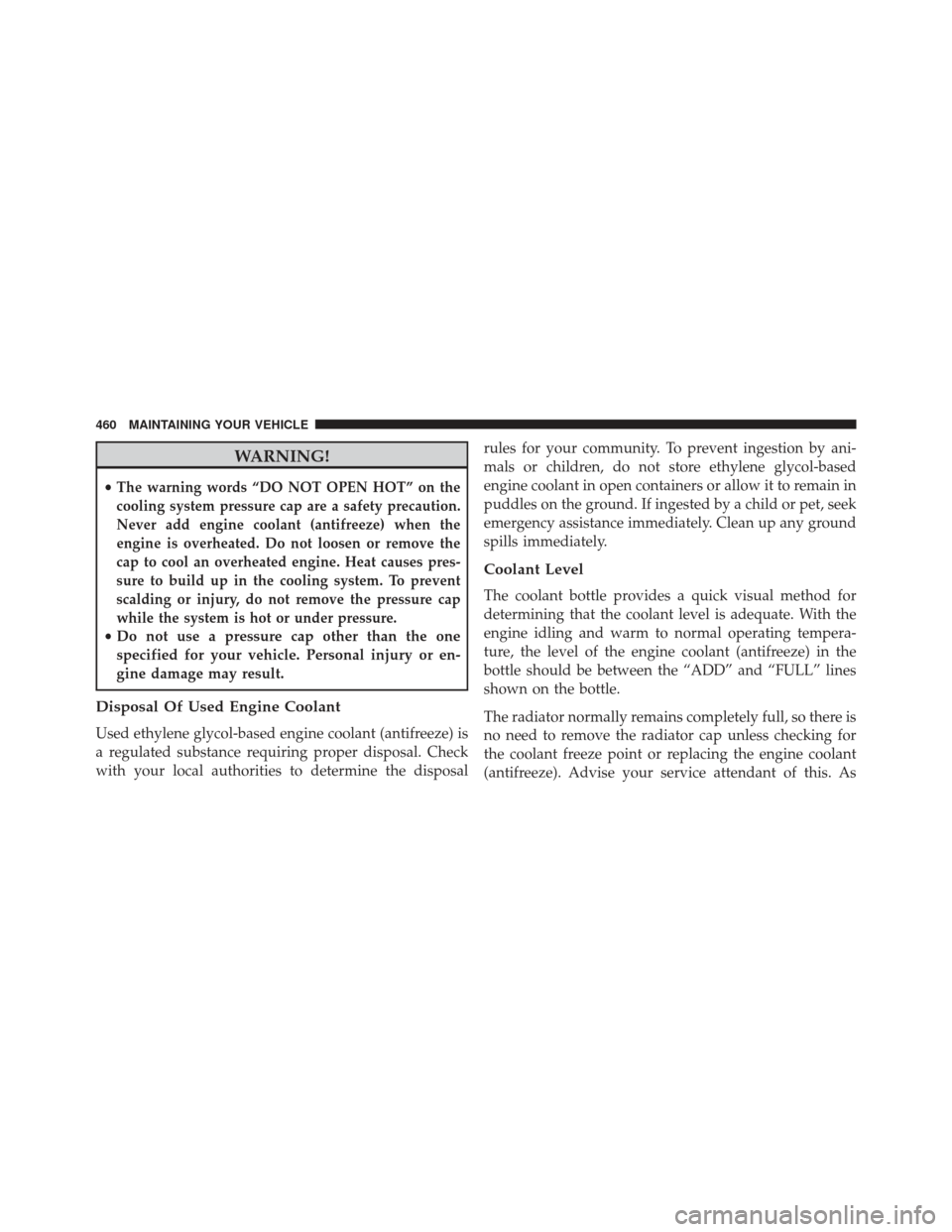
WARNING!
•The warning words “DO NOT OPEN HOT” on the
cooling system pressure cap are a safety precaution.
Never add engine coolant (antifreeze) when the
engine is overheated. Do not loosen or remove the
cap to cool an overheated engine. Heat causes pres-
sure to build up in the cooling system. To prevent
scalding or injury, do not remove the pressure cap
while the system is hot or under pressure.
• Do not use a pressure cap other than the one
specified for your vehicle. Personal injury or en-
gine damage may result.
Disposal Of Used Engine Coolant
Used ethylene glycol-based engine coolant (antifreeze) is
a regulated substance requiring proper disposal. Check
with your local authorities to determine the disposal rules for your community. To prevent ingestion by ani-
mals or children, do not store ethylene glycol-based
engine coolant in open containers or allow it to remain in
puddles on the ground. If ingested by a child or pet, seek
emergency assistance immediately. Clean up any ground
spills immediately.
Coolant Level
The coolant bottle provides a quick visual method for
determining that the coolant level is adequate. With the
engine idling and warm to normal operating tempera-
ture, the level of the engine coolant (antifreeze) in the
bottle should be between the “ADD” and “FULL” lines
shown on the bottle.
The radiator normally remains completely full, so there is
no need to remove the radiator cap unless checking for
the coolant freeze point or replacing the engine coolant
(antifreeze). Advise your service attendant of this. As
460 MAINTAINING YOUR VEHICLE
Page 510 of 525
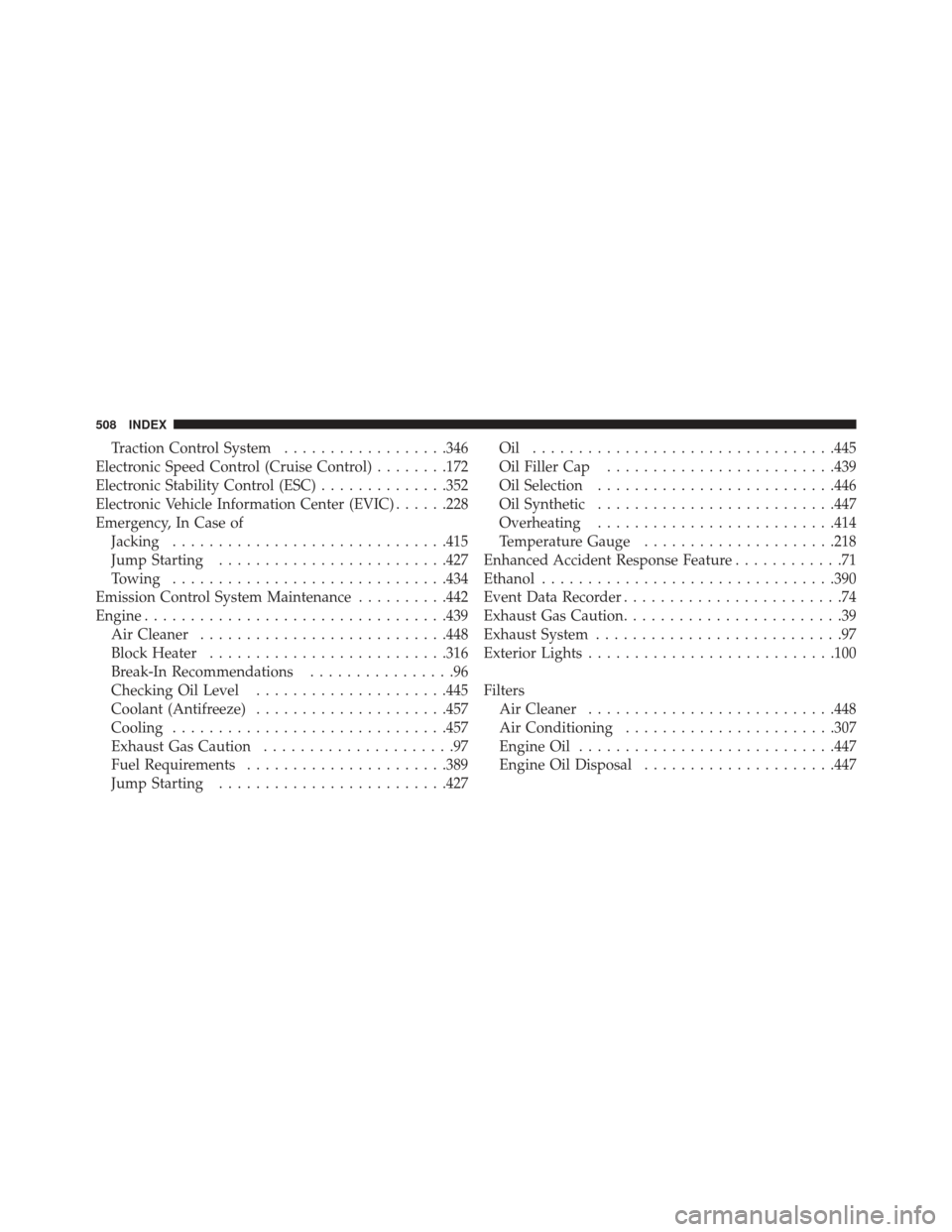
Traction Control System..................346
Electronic Speed Control (Cruise Control) ........172
Electronic Stability Control (ESC) ..............352
Electronic Vehicle Information Center (EVIC) ......228
Emergency, In Case of Jacking ............................. .415
Jump Starting ........................ .427
Towing ............................. .434
Emission Control System Maintenance ..........442
Engine ................................ .439
Air Cleaner .......................... .448
Block Heater ......................... .316
Break-In Recommendations ................96
Checking Oil Level .....................445
Coolant (Antifreeze) .....................457
Cooling ............................. .457
Exhaust Gas Caution .....................97
Fuel Requirements ..................... .389
Jump Starting ........................ .427Oil ................................
.445
Oil Filler Cap ........................ .439
Oil Selection ......................... .446
Oil Synthetic ......................... .447
Overheating ......................... .414
Temperature Gauge .....................218
Enhanced Accident Response Feature ............71
Ethanol ............................... .390
Event Data Recorder ........................74
Exhaust Gas Caution ........................39
Exhaust System ...........................97
Exterior Lights .......................... .100
Filters Air Cleaner .......................... .448
Air Conditioning ...................... .307
Engine Oil ........................... .447
Engine Oil Disposal .....................447
508 INDEX
Page 516 of 525
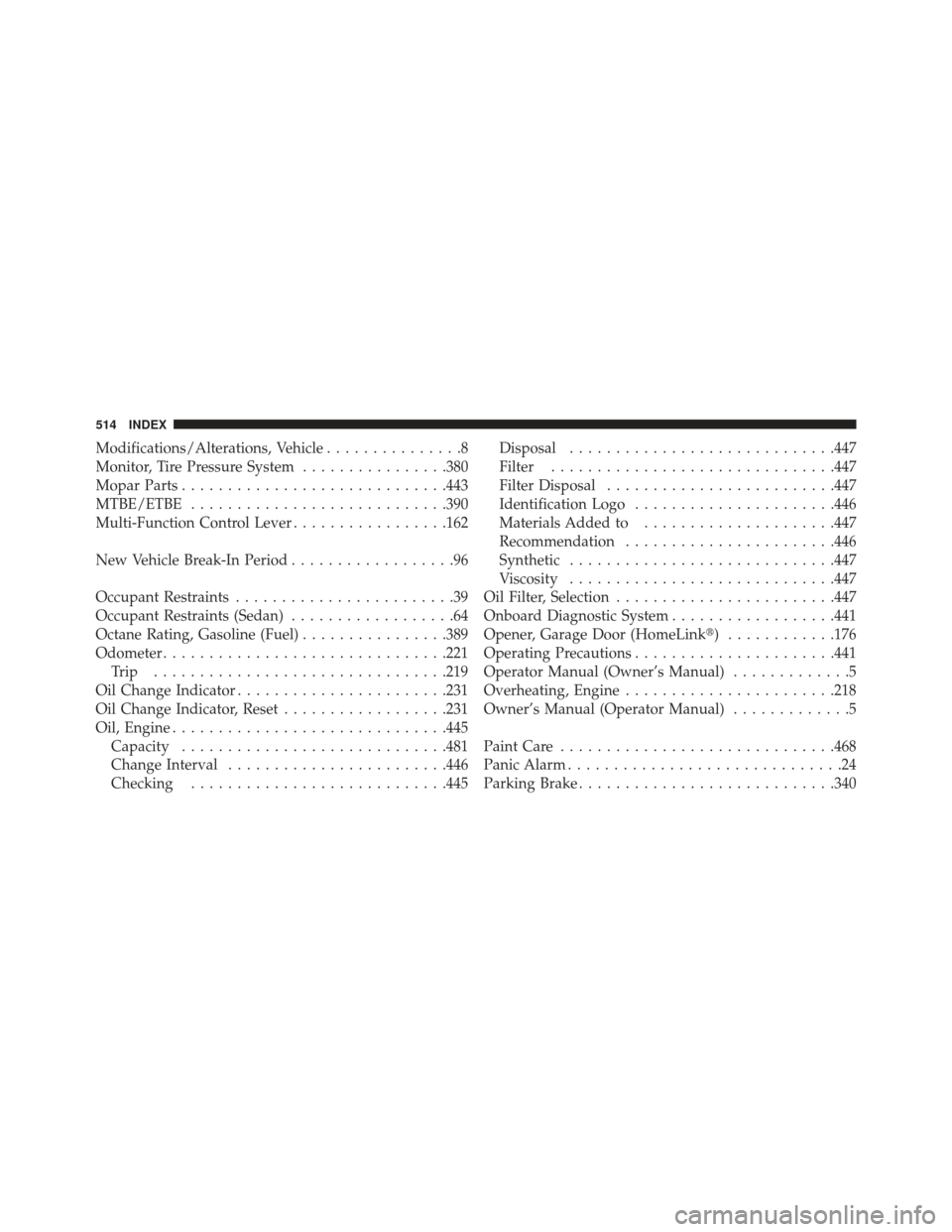
Modifications/Alterations, Vehicle...............8
Monitor, Tire Pressure System ................380
Mopar Parts ............................ .443
MTBE/ETBE ........................... .390
Multi-Function Control Lever .................162
New Vehicle Break-In Period ..................96
Occupant Restraints ........................39
Occupant Restraints (Sedan) ..................64
Octane Rating, Gasoline (Fuel) ................389
Odometer .............................. .221
Trip ............................... .219
Oil Change Indicator ...................... .231
Oil Change Indicator, Reset ..................231
Oil, Engine ............................. .445
Capacity ............................ .481
Change Interval ....................... .446
Checking ........................... .445Disposal
............................ .447
Filter .............................. .447
Filter Disposal ........................ .447
Identification Logo ..................... .446
Materials Added to .....................447
Recommendation ...................... .446
Synthetic ............................ .447
Viscosity ............................ .447
Oil Filter, Selection ....................... .447
Onboard Diagnostic System ..................441
Opener, Garage Door (HomeLink�) ............176
Operating Precautions ..................... .441
Operator Manual (Owner’s Manual) .............5
Overheating, Engine ...................... .218
Owner’s Manual (Operator Manual) .............5
Paint Care ............................. .468
Panic Alarm ..............................24
Parking Brake ........................... .340
514 INDEX